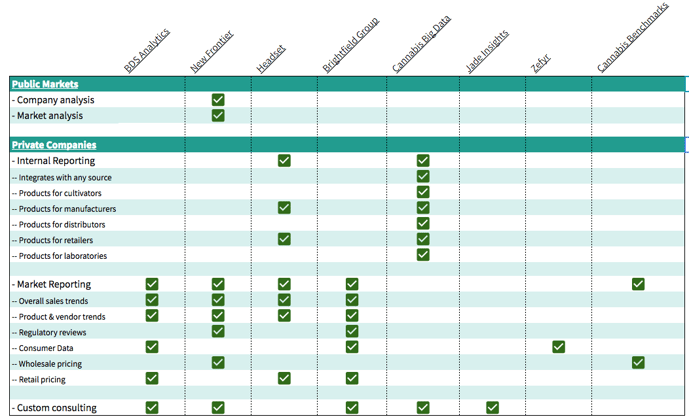Key Highlights:
- Ancillary cannabis business owners need to understand the available data options and how to use them to maximize their probability of success
- Data & reporting is a part of every modern day service, so you need the tools & the know how to empower your customers and partners
- External market data is important for understanding market trends, identifying the total addressable market, and building your financial modeling
- Internal company data (for your clients and your own company) is critical for tracking performance, improving your product or service, and attracting investors with a robust data-driven conversation

The cannabis industry is growing at an incredible rate and our industry is one of the sexiest and most exciting new markets in multiple lifetimes. What an opportunity to capitalize on, and be a part of, a new wave of conscious capitalism!
Thanks to sweeping medical and recreational legalization across the world, a lot of media and outside attention is focused on licensed, plant-touching cannabis businesses. Licensed operators are the epicenter of our industry, and they do incredibly difficult and meaningful work. Yet when investors and long-term industry analysts discuss areas where there is the greatest potential for financial gain and industry impact, many forward-thinkers point to the “picks and shovels” of the cannabis industry - the product and service providers that support and empower licensed operators. To extend the metaphor of the “green gold rush,” the individual that easily made the most money, and had the most powerful impact on the multi-decade gold rush, was none other than Levi Strauss. Every panner needs two pairs of jeans and a pan, but not every panner strikes gold. So too in the cannabis industry - not every licensed operator will strike green gold, but all of them need the software, products, and services that give them the opportunity to try their hand at growing, manufacturing, distributing, or selling cannabis products.
So if you’re thinking about, or have already started, an ancillary cannabis business, you’re in the right place at the right time! But how do you know where to start? Or who to serve? Or what to offer them? Or how to entice investors and your first few customers? The answer, in all cases, is by using the right data in the right ways.
If you’ve heard the terms “cannabis business intelligence” or “cannabis data” and have no idea what they mean, you are in good company with just about everyone in the industry. These phrases are broad and vague, so the purpose of this article is to provide a general primer on the different types of data elements and sources that are most relevant for ancillary cannabis entrepreneurs. We recently shared a comprehensive list of all cannabis data companies, so in this article, we’ll speak to which vendors are relevant for each area we discuss.
If you’re just getting started, who will you serve and how will you serve them?
For those interested in getting involved, or just getting started, in an ancillary cannabis business, the very first question you’ll want to answer is what segment of the market are you going to serve? And what pain point are you solving?
For example, thanks to the very diligent work from the analysts at Cannabis Benchmarks, we know that wholesale cannabis prices are plummeting across the US. This is a trend that’s expected to continue for the foreseeable future, and will only accelerate as artificial borders created by interstate and international commerce limitations are lifted in the US and around the world. Practically, that trend puts a lot of pressure on the profit margins for cultivators and creates a very pressing need for greater efficiency, automation, and scaling for growers. That is a problem they need help addressing right now!
On the other hand, thanks to the great tracking and analysis from BDS Analytics, the dropping costs of raw materials are not matched by a proportionate drop in the price of manufactured goods like vape cartridges, tinctures, topicals, and the like. In other words, the cost savings are not fully passed on to the customers. That dynamic creates a growing profit margin for manufacturers and creates a completely different opportunity for ancillary entrepreneurs.
This is just one example of thousands for the power of data to inform your strategic planning and value proposition. To be bluntly clear, the most successful ancillary cannabis entrepreneurs know how to find and use actionable data.
Now that you’ve decided your target customers, use the data to make a profitable business model
Ok, so you’ve zeroed in on the people you’d like to support and how you are going to help them earn more or stress less. Awesome and great job - this is already a very meaningful milestone worth celebrating! But is your business going to be profitable and sustainable?
Early on in the development of their business, every entrepreneur has to decide if they are building a lifestyle business or a venture-backed business. Please note: the two are usually mutually exclusive!
A lifestyle business is one that supports your desired lifestyle (and is usually sustained for a very long time), but is unlikely to be sold or to generate a windfall profit event. A venture-backed business is one that is built to sell because investors make their returns when their portfolio companies go public (unlikely for most ancillary businesses) or when they are sold. Because venture businesses also typically have outside investment, there is usually a comprehensive due diligence packet, complete with financial modeling (also called a pro forma), a board of directors, and more effort around navigating investor relations (and investor desires).
When building out your pro forma, you absolutely must know the size of your Total Addressable Market (TAM). The TAM is the number of potential customers if you converted 100% of all your prospective buyers. Data companies such as New Frontier, and directory services such as Cannabiz Media, as well as direct state disclosures are a good place to start to identify your TAM.
For those interested in inspiring outside investors, entrepreneurs must realize that any rational investors will struggle to take seriously and put money in an ancillary cannabis business that do not have a strong command of their past business performance and projections for future performance. More to the point, most investors agree that there is a lot of data captured by their dealflow companies, and it’s just really hard to extract and make dollars and cents of that data! The real challenge, then, isn’t the amount of information or even where to find it - the biggest pain point is connecting the data dots to tell a coherent story of the past, present, and future of every department, and every aspect, of your operation.
To build your model, use external data; to understand your business, use internal data
In needing to build strategy and investor decks, it’s natural for entrepreneurs to need to know industry trends grounded in external metrics (data points gathered as market research by 3rd-party vendors). But to prove the value and success of the business proper, or to provide valuable services to their licensed customers, entrepreneurs really need to master internal metrics (data points from inside your or your customer’s business). So as important as it is to understand the market dynamics, it’s even more important to start by locking in your internal reporting needs first and foremost. This internal clarity will improve profits, operations, investor relations, external comparisons and, most importantly, peace of mind.
Typical internal data that is worth mastering includes, but is not limited to:
- Gross and Net Profits
- Cost Centers
- Revenue Centers
- Customer Insights
- Product Performance
- Employee Performance
- Inventory Management (for physical products)
- Development Pipelines (for software products)
- Cultivation Yields (for growers)
- Manufacturing Yields (for manufacturers)
- Sales Campaigns
Once you have pristine clarity for looking within, then it makes sense to put internal metrics in the context of market benchmarks from external research firms. Some external metrics that are incredibly helpful to track:
- Wholesale prices for raw flower + manufactured products
- Retail prices for raw flower + manufactured products
- Market trends for product categories & brand penetration
- Market trends for consumer sentiment
- Overall growth in sales for your country, state / province, and local area
Cannabis data companies, what they do, and when they’re useful
In a past post, we listed all the cannabis data companies we are aware of, and here we are going to briefly organize them according to the public vs. private and internal vs. external framework that we’ve addressed in this post.
For ancillary companies in the private markets, New Frontier, BDS Analytics, Brightfield Group, Cannabis Benchmarks, and Headset all focus on market-level trending and reports.
For companies that offer internal reporting tools, Headset works with licensed operators and only Cannabis Big Data offers out-of-the-box automated reporting for both licensed and ancillary entrepreneurs. Of those two companies, only Cannabis Big Data integrates with every software and spreadsheet, and only Cannabis Big Data has modules for every vertical in the industry.
Of notable callout are Jade Insights, which is primarily a custom data consulting shop, and Zefyr, which collates publicly available data to support vendors selling into dispensaries.
 (c) Cannabis Big Data Do not replicate without express permission & reference link
(c) Cannabis Big Data Do not replicate without express permission & reference link
Know the cannabis data insights you’re looking for to maximize your time ROI plus where and how how you’ll get it
So what information and actionable insights do you need to succeed? Will you be most empowered with market-level data or insights from internal business data?
Now that you have some clarity around what, exactly, will empower your entrepreneurial needs, you can hone in on the right data vendor to support your needs. Each and every data vendor in the cannabis industry is contributing necessary, valuable information - the only question is what do you need to earn more and stress less?
--
![[Headshot]Cannabis Big Data_Henry Finkelstein](https://go.canopyboulder.com/hs-fs/hubfs/%5BHeadshot%5DCannabis%20Big%20Data_Henry%20Finkelstein.jpg?width=125&name=%5BHeadshot%5DCannabis%20Big%20Data_Henry%20Finkelstein.jpg) This article was written by Henry Finkelstein, CEO and Founder of Cannabis Big Data, who is on a mission to empower colleagues and clients by spinning data into gold with intuitive, actionable insights. After working in e-commerce, consulting, healthcare and government contracting, Henry saw the opportunity to create a modern-day data toolkit for licensed cannabis businesses that connects all the data dots with simple, intuitive, one-click reports & dashboards.
This article was written by Henry Finkelstein, CEO and Founder of Cannabis Big Data, who is on a mission to empower colleagues and clients by spinning data into gold with intuitive, actionable insights. After working in e-commerce, consulting, healthcare and government contracting, Henry saw the opportunity to create a modern-day data toolkit for licensed cannabis businesses that connects all the data dots with simple, intuitive, one-click reports & dashboards.

